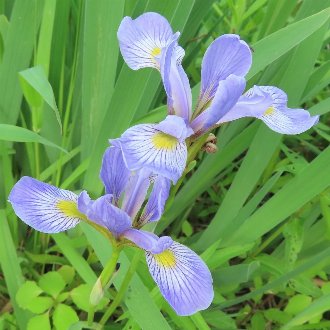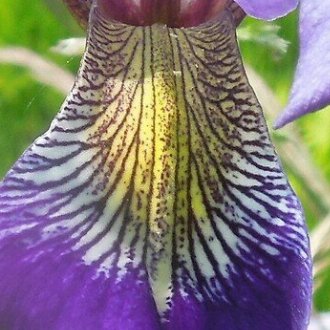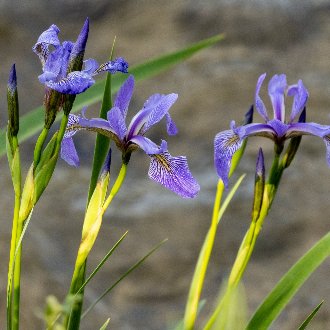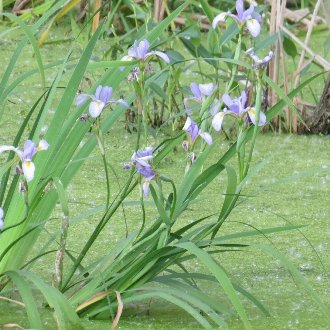Northern Blue Flag vs Southern Blue Flag
These two species are visually similar, but there are numerous small differences that can be used to distinguish them, particularly when they are in bloom. They have a narrow band of overlap through VA, MD, WV, OH, MI, and MN, but both can be planted in gardens outside their native ranges. These species are closely related and can hybridize in the wild, horticultural hybrids are widely planted, and hybrids are fertile thus leading to backcrosses and intergrades, so it may not be possible to identify all plants to species level. These species mostly inhabit similar habitats. I. versicolor may tolerate slightly more shade, whereas I. virginica may be slightly more likely to occur in disturbed habitats like roadside ditches.
Northern Blue Flag (Iris versicolor) | Southern Blue Flag (Iris virginica) |
A showy, rhizomatous perennial native to wetlands and land-water borders in the northeastern US and eastern Canada. | A showy, rhizomatous perennial native to wetlands and land-water borders mostly in the southeastern US but extending farther north in the Midwest. |
Flowers average a deeper, darker blue or purple color. Photo © Norma Malinowski, CC BY 4.0. | Flowers average a paler blue or purple color. Photo © Eric Schmidt, Public Domain. |
Yellow "signal" on sepals is paler, often more greenish, and fades in at the borders. Dark veins are bolder and more contrasting with the background. Photo © Michael, CC BY 4.0. | Yellow "signal" on sepals is a richer, deeper yellow, and has well-defined borders. Dark veins are paler and less prominent. Photo © Samuel A. Schmid, CC BY 4.0. |
Uppermost leaves on stems usually stay well below the flowers. Flowers are usually the highest point on the plant when viewed from the side, not usually obscured by leaves. Photo © Jay Brasher, CC BY 4.0. | Uppermost leaves on stems often rise above the the flowers. Flowers tend to be lower than tallest leaves and are often partly obscured by them when viewed from the side. Photo © Kaden Slone, CC BY 4.0. |
Stems are shorter (to 2 feet / 6 dm) but are stronger and more likely to remain straight or only lean slightly. Photo © Jonathan Bayer, CC BY 4.0. | Stems can grow longer (to about 3.25 feet / 10dm) but tend to be weaker and often lean considerably, or even fall over. Photo © Marilynn Miller, CC BY 4.0. |
Petals are noticeably shorter (usually <2/3rd) as long as the sepals (which have the yellow signal on them.) Photo © Tom Scavo, CC BY 4.0. | Petals are > 2/3rd as long as the sepals, and are often similar in length. Photo © Marie Chappell, CC BY 4.0. |
Additional Notes
We found it difficult to locate any reliable sources on the habitat preferences of these species where their ranges overlap. Some sources claim I. virginica prefers lower soil pH but this seems unlikely given that it also occurs in calcarceous and mafic fens, and that I. versicolor occurs in bogs, although it is possible that thes species have this relative pH preference in their areas of overlap since species often prefere more calcium-rich, higher-pH environments towards their southern range limits.If we were to speculate on any habitat differences on the basis of growth habit, it would seem most likely that I. versicolor would be more tolerant of competition from other plants because of its taller but less self-supporting stems. This observation is consistent with its preference for more disturbed habitats.
Because any habitat preferences are subtle at best, it is best to assume that either species can occur in any habitat and to rely primarily on flowers for an ID.
References & External Resources
These short lists show only links helpful for ID. For a complete list of references and resources also covering other aspects of ecology, visit the links section of the full article on each plant, which is the first entry here.












